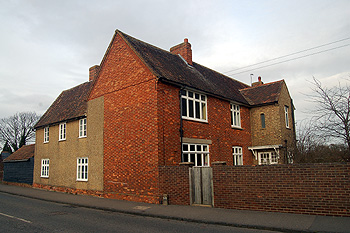Village Farm Elstow

Village Farmhouse, February 2012
Village Farmhouse was listed by English Heritage in May 1984 as Grade II – of special interest. At a casual glance the property does not look particularly old because it has a large 19th century component. However, the original part of the building dates from the 17th century. This part, fronting the road and on the left hand side, is timber framed with pebbledash render. The later blocks, larger than the original, are to the south and rear and are constructed from chequered red and yellow brick. All the roofs are composed of clay tiles. The original building contained two rooms upstairs and down with one back-to-back hearth serving both rooms. There is a single storey lean-to at the rear.
The Rating and Valuation Act 1925 specified that every building and piece of land in the country was to be assessed to determine its rateable value. The valuer visiting Village Farm [ref: DV1/H48/12] found that it was like most of the parish in that it was owned by Lord of the Manor Samuel Howard Whitbread.
The tenant was Alfred Prole, presumably a relation of Mary Prole at Lynn Farm. His rent was £304 per annum, fixed in 1921, the previous rent having been £182/14/- per annum fixed in 1890. The farm comprised 174 acres. The valuer commented: “Rent very high” and he noted “25 acres grass floods and is very coarse. Position of house and homestead for working farm”.
The house comprised three reception rooms, a kitchen, a scullery and a dairy with four bedrooms, dressing room and a box room upstairs. A coal store and two earth closets stood outside. Drainage was to a cess pool. The homestead comprised the following ranges of buildings:
By the gate: a trap house; a three stall stable; a harness room; a stable for six horses; a chaff house; two loose boxes; a two
bay open hovel; a three bay open hovel; a cow place for eight beasts; a cow place for two and a mixing place; In a second yard: a loose box; a two bay open hovel and a corn and straw barn; In the rickyard: a large implement bay and a four bay cart hovel; “At the bottom of the garden and beyond”: two chicken houses.
The valuer noted: “No drainage. Porous bottom both yards”.